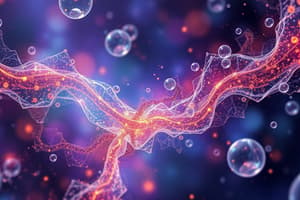Podcast
Questions and Answers
What is the primary distinction between diffusion and osmosis?
What is the primary distinction between diffusion and osmosis?
- Osmosis is significantly faster than diffusion in distributing molecules.
- Diffusion involves the movement of any molecule, while osmosis specifically refers to the movement of water.
- Osmosis requires a semipermeable membrane, while diffusion does not. (correct)
- Diffusion occurs from areas of low concentration to high concentration, while osmosis occurs from high to low.
A plant cell is placed in a solution with a higher water concentration than its cytoplasm. Which of the following is most likely to occur?
A plant cell is placed in a solution with a higher water concentration than its cytoplasm. Which of the following is most likely to occur?
- There will be no net movement of water, and the cell will remain the same.
- Water will move out of the cell, causing it to shrink.
- The cell membrane will become impermeable to water.
- Water will move into the cell, potentially causing it to swell. (correct)
Which factor primarily determines whether a molecule can pass through a semipermeable membrane?
Which factor primarily determines whether a molecule can pass through a semipermeable membrane?
- The molecule's size relative to the membrane's pore size. (correct)
- The molecule's concentration gradient.
- The molecule's charge.
- The molecule's solubility in water.
In the thistle funnel experiment, why does the solution rise in the narrow part of the funnel?
In the thistle funnel experiment, why does the solution rise in the narrow part of the funnel?
You have a semipermeable bag filled with a 20% salt solution. You place this bag into a beaker of distilled water. What will happen to the bag over time?
You have a semipermeable bag filled with a 20% salt solution. You place this bag into a beaker of distilled water. What will happen to the bag over time?
Which of the following is NOT considered a semipermeable membrane in a plant cell?
Which of the following is NOT considered a semipermeable membrane in a plant cell?
What is 'osmotic pressure' a measure of?
What is 'osmotic pressure' a measure of?
How does the presence of wind or water currents affect the distribution of molecules, compared to diffusion alone?
How does the presence of wind or water currents affect the distribution of molecules, compared to diffusion alone?
Which of the following best explains why actively growing tissues, such as fruits and flowers, typically have a higher water content compared to dormant tissues like seeds?
Which of the following best explains why actively growing tissues, such as fruits and flowers, typically have a higher water content compared to dormant tissues like seeds?
A botanist measures the fresh weight of a plant leaf to be 10g. After drying the leaf in an oven, the dry weight is measured at 2g. What is the water content of the leaf, expressed as a percentage of its fresh weight?
A botanist measures the fresh weight of a plant leaf to be 10g. After drying the leaf in an oven, the dry weight is measured at 2g. What is the water content of the leaf, expressed as a percentage of its fresh weight?
How does water contribute to the structural integrity of plant organs?
How does water contribute to the structural integrity of plant organs?
Which of the following processes relies most directly on the solvent properties of water within a plant?
Which of the following processes relies most directly on the solvent properties of water within a plant?
What is the most likely consequence of a plant experiencing prolonged water deficiency?
What is the most likely consequence of a plant experiencing prolonged water deficiency?
If solution A has a water potential (ΨA) of -0.5 MPa and solution B has a water potential (ΨB) of -0.3 MPa, what is the driving force (ΔΨw) on water movement?
If solution A has a water potential (ΨA) of -0.5 MPa and solution B has a water potential (ΨB) of -0.3 MPa, what is the driving force (ΔΨw) on water movement?
A plant cell is placed in a solution. If the pressure potential (Ψp) inside the cell is 0.3 MPa and the solute potential (Ψs) is -0.7 MPa, what is the overall water potential (Ψw) of the cell?
A plant cell is placed in a solution. If the pressure potential (Ψp) inside the cell is 0.3 MPa and the solute potential (Ψs) is -0.7 MPa, what is the overall water potential (Ψw) of the cell?
How does the high heat capacity of water contribute to the survival of plants in fluctuating temperature environments?
How does the high heat capacity of water contribute to the survival of plants in fluctuating temperature environments?
What is the primary role of water in the germination process?
What is the primary role of water in the germination process?
How does increasing the salt concentration in a solution affect its osmotic potential (Ψs)?
How does increasing the salt concentration in a solution affect its osmotic potential (Ψs)?
Which factor would decrease the rate of diffusion?
Which factor would decrease the rate of diffusion?
Carnivorous plants, such as the Venus flytrap, utilize water in their trapping mechanisms. How is water most likely involved in the rapid leaf movements of these plants?
Carnivorous plants, such as the Venus flytrap, utilize water in their trapping mechanisms. How is water most likely involved in the rapid leaf movements of these plants?
Which of the following statements accurately describes the pressure potential (Ψp) under different pressure conditions?
Which of the following statements accurately describes the pressure potential (Ψp) under different pressure conditions?
A flaccid plant cell with a water potential of -0.8 MPa is placed in a solution with a water potential of -0.5 MPa. What will happen to the cell?
A flaccid plant cell with a water potential of -0.8 MPa is placed in a solution with a water potential of -0.5 MPa. What will happen to the cell?
In the context of diffusion, what is meant by a 'dynamic equilibrium'?
In the context of diffusion, what is meant by a 'dynamic equilibrium'?
Which component of a plant cell provides rigidity but also allows for some elasticity under pressure?
Which component of a plant cell provides rigidity but also allows for some elasticity under pressure?
Robert Brown's observation of 'Brownian movement' demonstrated what key principle related to diffusion?
Robert Brown's observation of 'Brownian movement' demonstrated what key principle related to diffusion?
If a substance is moving against a diffusion gradient, which of the following is true?
If a substance is moving against a diffusion gradient, which of the following is true?
A plant cell has a solute potential (Ψs) of -0.6 MPa. It is then placed in a solution where, at equilibrium, its pressure potential (Ψp) is 0.4 MPa. What is the water potential of the surrounding solution at equilibrium?
A plant cell has a solute potential (Ψs) of -0.6 MPa. It is then placed in a solution where, at equilibrium, its pressure potential (Ψp) is 0.4 MPa. What is the water potential of the surrounding solution at equilibrium?
Which of the following cellular structures is surrounded by the tonoplast?
Which of the following cellular structures is surrounded by the tonoplast?
Why is diffusion considered a spontaneous process?
Why is diffusion considered a spontaneous process?
Considering the time it takes for a glucose molecule to diffuse 1 meter, what does this suggest about the efficiency of diffusion over long distances in cells?
Considering the time it takes for a glucose molecule to diffuse 1 meter, what does this suggest about the efficiency of diffusion over long distances in cells?
A scientist observes a dye spreading in a solution. The rate of diffusion increases when they apply pressure to the system. Which of the following can be concluded?
A scientist observes a dye spreading in a solution. The rate of diffusion increases when they apply pressure to the system. Which of the following can be concluded?
Two containers are separated by a permeable membrane. Container A has a high concentration of solute X, and Container B has a low concentration of solute X. Assuming no other factors are influencing diffusion, what will happen over time?
Two containers are separated by a permeable membrane. Container A has a high concentration of solute X, and Container B has a low concentration of solute X. Assuming no other factors are influencing diffusion, what will happen over time?
In a turgid plant cell, what is the relationship between turgor pressure and wall pressure?
In a turgid plant cell, what is the relationship between turgor pressure and wall pressure?
What causes the crispy sensation when chewing fresh lettuce leaves?
What causes the crispy sensation when chewing fresh lettuce leaves?
How does potassium contribute to water movement in plant cells?
How does potassium contribute to water movement in plant cells?
Which of the following best describes the initial process of seed imbibition?
Which of the following best describes the initial process of seed imbibition?
What is the primary driving force behind the imbibition of water by seeds?
What is the primary driving force behind the imbibition of water by seeds?
What structural changes occur in the seed coat during imbibition that facilitate water penetration?
What structural changes occur in the seed coat during imbibition that facilitate water penetration?
How does water disrupt the structure of cell walls during seed imbibition?
How does water disrupt the structure of cell walls during seed imbibition?
What is the significance of the increase in seed volume during imbibition?
What is the significance of the increase in seed volume during imbibition?
How does the structure of a seed coat affect the process of imbibition?
How does the structure of a seed coat affect the process of imbibition?
In the context of imbibition, what role does the surrounding water potential play?
In the context of imbibition, what role does the surrounding water potential play?
How does temperature generally affect the rate of imbibition in seeds?
How does temperature generally affect the rate of imbibition in seeds?
How do the texture and type of imbibant influence the process of imbibition?
How do the texture and type of imbibant influence the process of imbibition?
Why do seeds with starch or protein reserves typically imbibe more water than those with oil reserves?
Why do seeds with starch or protein reserves typically imbibe more water than those with oil reserves?
Flashcards
Fresh Weight (FW)
Fresh Weight (FW)
The weight of freshly harvested plant tissues.
Dry Weight (DW)
Dry Weight (DW)
The weight of plant tissues after all water has evaporated.
Water Content Calculation
Water Content Calculation
Water content is the difference between fresh weight and dry weight (FW - DW).
Water Content Percentage
Water Content Percentage
Signup and view all the flashcards
Water as a Solvent
Water as a Solvent
Signup and view all the flashcards
Water & Plant Shape
Water & Plant Shape
Signup and view all the flashcards
Water & Nutrient Transport
Water & Nutrient Transport
Signup and view all the flashcards
Water & Cooling
Water & Cooling
Signup and view all the flashcards
Diffusion
Diffusion
Signup and view all the flashcards
Solution (in Botany)
Solution (in Botany)
Signup and view all the flashcards
Osmosis
Osmosis
Signup and view all the flashcards
Semipermeable Membrane
Semipermeable Membrane
Signup and view all the flashcards
Differentially Permeable Membranes
Differentially Permeable Membranes
Signup and view all the flashcards
Tonoplast
Tonoplast
Signup and view all the flashcards
Osmotic Pressure
Osmotic Pressure
Signup and view all the flashcards
Diffusion Rate and Molecule Size
Diffusion Rate and Molecule Size
Signup and view all the flashcards
Brownian Movement
Brownian Movement
Signup and view all the flashcards
Along a Diffusion Gradient
Along a Diffusion Gradient
Signup and view all the flashcards
Against a Diffusion Gradient
Against a Diffusion Gradient
Signup and view all the flashcards
Dynamic Equilibrium (in Diffusion)
Dynamic Equilibrium (in Diffusion)
Signup and view all the flashcards
Spontaneous Movement
Spontaneous Movement
Signup and view all the flashcards
Temperature and Diffusion Rate
Temperature and Diffusion Rate
Signup and view all the flashcards
Density/Viscosity and Diffusion Rate
Density/Viscosity and Diffusion Rate
Signup and view all the flashcards
Seed Coat Structure
Seed Coat Structure
Signup and view all the flashcards
Water Availability
Water Availability
Signup and view all the flashcards
Temperature
Temperature
Signup and view all the flashcards
Imbibant Texture
Imbibant Texture
Signup and view all the flashcards
Type of Imbibants
Type of Imbibants
Signup and view all the flashcards
ΔΨw
ΔΨw
Signup and view all the flashcards
ΔΨw Calculation
ΔΨw Calculation
Signup and view all the flashcards
Water potential (Ψw) formula
Water potential (Ψw) formula
Signup and view all the flashcards
Osmotic potential (Ψs)
Osmotic potential (Ψs)
Signup and view all the flashcards
Pressure potential (Ψp)
Pressure potential (Ψp)
Signup and view all the flashcards
Plant cell wall properties
Plant cell wall properties
Signup and view all the flashcards
Protoplast
Protoplast
Signup and view all the flashcards
Turgor Pressure
Turgor Pressure
Signup and view all the flashcards
Wall Pressure
Wall Pressure
Signup and view all the flashcards
Turgid Plant Cell
Turgid Plant Cell
Signup and view all the flashcards
Potassium in Plants
Potassium in Plants
Signup and view all the flashcards
Osmosis in Plants
Osmosis in Plants
Signup and view all the flashcards
Seed Imbibition
Seed Imbibition
Signup and view all the flashcards
Physical Adsorption
Physical Adsorption
Signup and view all the flashcards
Capillary Action in Seeds
Capillary Action in Seeds
Signup and view all the flashcards
Study Notes
- Water is vital for plant life, serving as the most abundant yet often the most limiting resource for growth and function
- Water content in plant tissues depends on tissue type, metabolic activity, and soil water status
- Fresh, actively growing tissues like fruits and flowers can be 90% water by weight
- Dry, non-actively tissues like seeds or wood can be 10% water or less by weight
Fresh Weight (FW) and Dry Weight (DW)
- Fresh weight (FW) is the weight of freshly harvested plant tissues
- Dry weight (DW) is the remaining weight after tissues are left in air or incubated in an oven at 70 °C for a few days to evaporate all water
- The difference between FW and DW indicates the water content in the tissue
Example of Water Content Calculation
- Start with a freshly harvested flower weighing 4g (FW = 4g)
- Incubate the flower at 70 °C for 3 days until all water evaporates, resulting in a dry weight of 0.5g (DW = 0.5g)
- Calculate the water content: Water content = FW – DW = 4 – 0.5 = 3.5g
- Water content percentage = (water content / FW) * 100 = (3.5/4) * 100 = 87.5%
- The high water content in metabolizing tissues reflects water's importance
Functions of Water in Plant Life
- Acts as a solvent for cellular molecules and a medium for enzymatic reactions
- Maintains the shape of plant organs and the plant body
- Transports solutes and nutrients up from the soil and throughout the plant body
- Cools the plant body
- Used for germination and growth of cells and the overall plant body
- Facilitates movement, such as the opening/closing of flowers and the movement of leaves in carnivorous plants (e.g., Venus flytrap)
Diffusion
- Molecules and ions are in constant, random motion
- Brownian movement, described by Robert Brown in 1827, explains this motion as bombardment of visible particles by invisible water molecules
- Diffusion: the movement of molecules or ions from high to low concentration regions
- Movement from high to low concentration is along a diffusion gradient
- Movement from low to high concentration is against a diffusion gradient
- Dynamic equilibrium is reached when molecules distribute evenly throughout available space
- Diffusion is spontaneous and doesn't need energy
- Diffusion rate is proportional to temperature and pressure
- Diffusion rate is inversely proportional to the density/viscosity of the medium and the size of diffusing molecules
Diffusion Example with Glucose
- It would take ~31 years for a glucose molecule to diffuse 1 meter long
- A glucose molecule can diffuse from one end of a cell to the other (10 micrometers) in about 0.88 seconds
Osmosis
- Solution: a mixture of substances where one is dissolved in another
- Osmosis: a special case of diffusion where water molecules move through a semipermeable membrane from high to low water concentration
- Semipermeable membranes have specific pore sizes, restricting larger molecules
- Plant cells have semipermeable membranes like the cell membrane and tonoplast
Osmosis Demonstration
- Tie a cellophane membrane over a thistle funnel filled with 10% sugar solution
- Immerse it in a beaker of distilled water, setting up demonstration of osmosis
- Water diffuses through the membrane from the distilled water to the sugar solution, causing the solution to rise inside the funnel
Osmotic Pressure and Solutions
- Osmotic pressure: the force driving water into the funnel through the semipermeable membrane
- Osmotic pressure is proportional to the concentration difference across the membrane
- Hypotonic solution: has a lower concentration of salt (higher concentration of water)
- Hypertonic solution: has a higher concentration of salt (lower concentration of water)
- Osmotic system: a hypotonic solution separated from a hypertonic solution by a semipermeable membrane
Water Potential
- Water potential (Ψ) measures free energy of water under temperature and pressure, relative to pure water
- Measured in pressure units (bar or pascal (Pa))
- 1 bar = 100000 Pa = 0.1 MPa
- Water potential (Ψw) of pure water at atmospheric pressure is zero
- Any solution (salt in water) has a water potential below zero (negative value)
- Water moves from high to low water potential
- Water in an osmotic system diffuses from pure water (Ψw = 0 MPa) to 0.1 M sucrose (Ψw = -0.24 MPa) demonstrating movement from high to low
Osmosis, Water Potential, and Salt Concentration
- During osmosis, water moves through a semipermeable membrane from a hypotonic solution with higher water potential or lower salt concentration
- Occurs to a hypertonic solution with lower water potential or higher salt concentration
Components of Water Potential
- The driving force of water movement example: ΔΨw = ΨA – ΨB
- ΔΨw= the driving force
- ΨA= water potential of solution A
- ΨB= water potential of solution B
- Water potential (Ψw) is comprised of osmotic potential (Ψs) and pressure potential (Ψp)
- Ψs (osmotic potential/solute potential): determined by solute concentration
- Pure water has a solute potential is zero
- Adding solutes lowers water potential, making it negative
- Osmotic potential of any solution is always negative
- The higher the salt concentration, the lower (more negative) the osmotic potential
- Osmotic potential is sometimes symbolized by Ψπ
- Ψp (pressure potential): physical pressure exerted on water in a system:
- Ψp at atmospheric pressure is zero
- Ψp above atmospheric pressure is positive
- Ψp below atmospheric pressure is negative
Plant Cell as an Osmotic System
- Plant cells have cellulose cell walls which provide rigidity and some elasticity
- Protoplast = cytoplasm with its components, surrounded by a plasma membrane
- Tonoplast: membrane surrounding a large vacuole inside the cytoplasm
- Cell membrane and tonoplast = semipermeable membranes that separate cytoplasmic solution from the outer environment
- Plant cell functions as an osmotic system where water moves from high to low water potential
Plasmolysis and Turgor Pressure
- Plasmolysis: the protoplast loses water and shrinks
- Occurs when the plant cell is surrounded by a high solute solution
- Deplasmolysis: the reverse of plasmolysis, the plasmolized cell returns to a turgid state when water diffuses back inside the protoplast
- Permanent plasmolysis: when plasmolysis is severe or prolonged, the cell dies and cannot deplasmolyze
- Turgor pressure: the turgid protoplast pushes against the cell wall, causing it to expand
- Wall pressure: the cell wall squeezes back on the protoplast, preventing further expansion
- Turgor and wall pressure are equal and opposite
- Turgid plant cells have their protoplast under pressure greater than atmospheric pressure
Additional Factors
- The crispness of lettuce is due to turgor pressure; cells explode when cell walls are ruptured during chewing
- Potassium ions regulate plant cell osmolarity
- Osmosis enables water movement from cell to cell by going from high to low water potential
Imbibition of Water by Seeds
- Seed imbibition: the initial stage of seed germination
- Seed imbibition enables seeds to transition from dormancy to active growth
- Involves absorption of water by dry seeds, leading to swelling and the activation of metabolic processes necessary for germination
- Imbibition: a physical adsorption process where water molecules adhere to seed food (starch/protein) and hydrophilic cell walls (cellulose, hemicellulose, pectins)
- Capillary action draws water into the microscopic pores and spaces of the seed coat and tissues
- The difference in water potential underlies the driving force behind imbibition
- Water causes the seed coat to hydrate, swell, and become permeable
- Water penetrates the embryo disrupting hydrogen bonds, causing cell walls to expand, which increases the seed volume
- Seed coat ruptures, facilitating water uptake and gaseous exchange
Factors Affecting Imbibition
- Seed Coat Structure: thickness, permeability, and composition of the seed coat
- Thick, impermeable coats may need mechanical scarification or pre-treatment
- Water Availability: Seeds in high water potential take up more water than seeds in low water potential
- Temperature: influences the rate of imbibition and metabolic activities. Higher the temperature, the faster the imbibition
- Texture/type of imbibants: seeds with loose structures imbibe easier than seeds that are in compact structures
- Seeds with starch/protein imbibe more water than seeds with oil.
- Wood is an excellent imbibant.
Studying That Suits You
Use AI to generate personalized quizzes and flashcards to suit your learning preferences.




